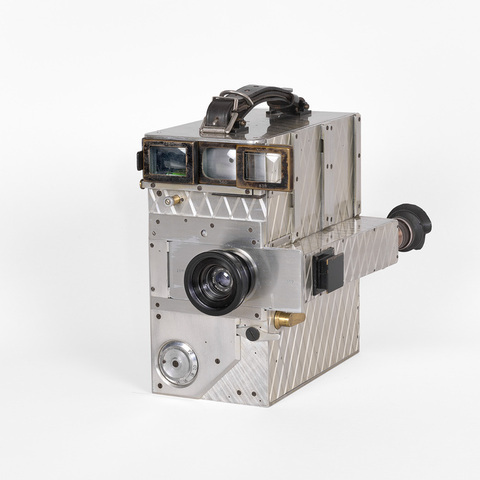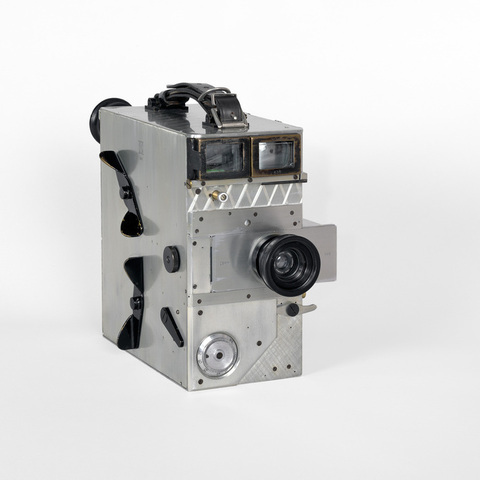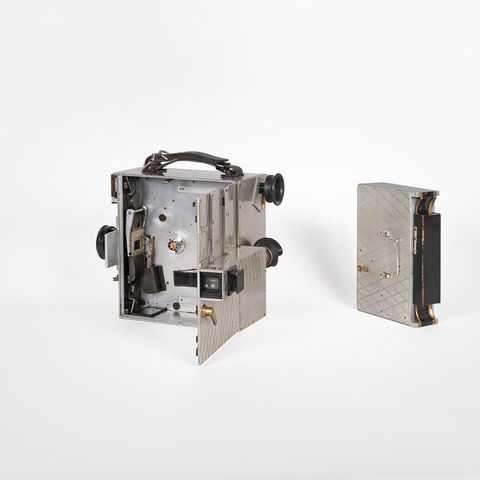Caméra film 35 mm
Fiche détaillée
Type de l'appareil
entraînement du film 35 mm par une griffe ; emplacement intérieur pour un chargeur débiteur et récepteur de 60 m.; moteur à ressort ; viseur reflex et viseur clair multifocal ; variateur de vitesse 12 à 40 images/seconde ; corps en duralumin ; une caisse de transport pour la caméra ; une caisse de transport pour quatre magasins et quatre objectifs supplémentaires
Auteurs
Informations non disponibles
Fabricants
James A. Sinclair
Londres, Highgate
Newman & Sinclair Ltd
Londres, Highgate
Utilisateurs
Informations non disponibles
Distributeurs
Informations non disponibles
Sujet du modèle
Informations non disponibles
Objectif
Cooke speed panchro lens n° 218 155 28 mm f. 2 ; Ross London patent 2 inch Xpres F. 1,9 n° 157 066 ; Ross London patent 6 inch Xpres F. 4,5 n° 159 300 ; Ross London patent 3 inch Xpres F. 1,9 n° 157 071 ; Ross London patent 1 1/2 inch Xpres F. 1,9 n° 163
Taille de l'objet
Ouvert :
Informations non disponibles
Fermé :
Longueur : 32 cm
Largeur : 20 cm
Hauteur : 28 cm
Diamètre :
Informations non disponibles
Taille de la boîte de transport
Longueur : 29 cm
Largeur : 43 cm
Hauteur : 32 cm
Remarques
Marque : "NS 560". Marque dans les deux caisses de transport : "James A. Sinclair & Co Ltd 3 Whitehall London SW 1".
"The Camera is entirely of metal, Duralumin being used for the body as experience shows that this metal is suitable for extremes of climate and for resistance to wear ; it is almost as strong as steel, and nearly as light as alumunium, but without the disadvantages of the latter metal. Weight has been reduced to the greatest extent, consistent with the maintenance of strenght and rigidity of structure. The plain rectangular shape is convenient both for operating and carrying. [...] The accurate fit of the camera door provides adequate protection for the internal mechanism when working in either very damp or very dustry climates. The camera is driven by a clockwork motor of unique design which obtains its power from two springs, each wound by a separate key on the right-hand side of the instrument. A very important feature of the camera is the ability to drive 200-ft (60 m) of film at one full winding of the two springs ; this has been achieved by the use of a sturdily built mechanism housing which prevents stress on the wheel pivots. All pivots are made of highly polished steel which reduces friction to the minimum, and eliminates the need for excessive oil. [...] The film gate mechanism is an assembly which can be removed from the camera as a complete unit, being released by the simple rotation of two levers. Positioning pins and generous bearing surface ensure its accurate restoration to the working position. The gate incorporates a compling pressure pad which is operated by a pad on the claw mechanism which lifts the film immediately before each pull down of the claw. The film then moves forward without contact of its sensitive surface with any part of the gate and at the end of the claw stroke the pressure pad drops the film down on to a registration pin which ensures its perfect positioning with relation to the gate aperture. The single intermittent claw is set to give a tolerance wide enough to allow for the differences in gauge which are caused by humidity and climatic conditions generally. All bearings are specifically designed to give rigidity to the single claw which enters the film from the rear. On removal of the gate mechanism from the camera it can be opened, thus making all working parts completely accessible for cleaning. Unless otherwise specified, all cameras are supplied with the standard Academy sound mask gate aperture, 22,04 mm x 16,03 mm" (Conditions of Sale, Londres, s.d.)
"The specification of the Model G Camera is as under : - Fixed shutter, frames 10-32 per second, 2 ins. or 50 mm. Anastigmat Lens in focussing mount scaled years, feet or metres to order, parallax adjustment to tunnel finder, supplementary finder lens and one film magazine incorporating ground glass and film (gate) focussing. [...] The camera works equally well in any position, upright, inverted, etc. Film stock is carried in readily interchangeable magazines which can be inserted into the camera in a few seconds in full daylight without risk or fogging. [...] The film footage indicator and camera level are visible in the finder. [...] The built-in optical view finder at the top of the camera shows a brilliant image right way up and right way round with a bold spirit level and film footage dial clearly to be seen in the lower part of the finder, so that these points can be checked without the operator having to change sighting position. The front of the camera carries rails which permit a supplementary finder lens or combination of finder lenses to be used to accord with the focal lenght employed. The tunnel finder alone shows the field of a 4 in. (100 mm) lens, whilst for other focal lengths appropriate supplementary finder lenses are provided, or if desired, the field of view of lenses 6 ins. or upwards can be shown by rectangles engraved on the front finder lens. The eye-piece of the finder is equipped with a rubber cap to form a convenient rest for the face and to keep out extraneous light, and moves on a calibrated sliding plate for the adjustment of parallax, scaled to 4 ft. or equivalent. The magazines are cast from a light metal allow of considerable strenght. They are absolutely light-tight, rectangular in form, and without projecting knobs or mechanism" (James A. Sinclair & Co. Ltd. Newman-Sinclair Auto Kine' Cameras, Photographic apparatus accessories and materials, London, James A. Sinclair, 1948).
Bibliographie
James A. Sinclair & Co. Ltd. Newman-Sinclair Auto Kine' Cameras, Photographic apparatus accessories and materials, London, 1948.


